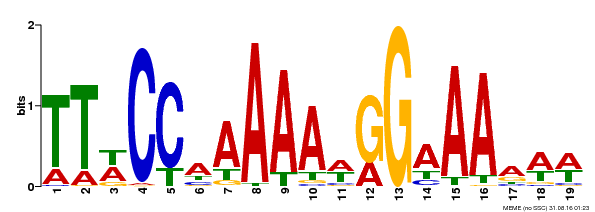| Signature Domain? help Back to Top |
 |
| No. |
Domain |
Score |
E-value |
Start |
End |
HMM Start |
HMM End |
| 1 | SRF-TF | 100.1 | 8.5e-32 | 9 | 58 | 1 | 50 |
S---SHHHHHHHHHHHHHHHHHHHHHHHHHHT-EEEEEEE-TTSEEEEEE CS
SRF-TF 1 krienksnrqvtfskRrngilKKAeELSvLCdaevaviifsstgklyeys 50
krienk+nrqvtfskRrng+lKKA+ELSvLCdaeva+iifss+gklye+
AT2G45650.1 9 KRIENKINRQVTFSKRRNGLLKKAYELSVLCDAEVALIIFSSRGKLYEFG 58
79**********************************************95 PP
|
| 2 | K-box | 99.9 | 3.6e-33 | 76 | 171 | 4 | 99 |
K-box 4 ssgksleeakaeslqqelakLkkeienLqreqRhllGedLesLslkeLqqLeqqLekslkkiRskKnellleqieelqkkekelqeenkaLrkkle 99
s ++++ e++++s++qe++kLk+++e+L r++R+llGedL+++ +keLq Le+qLe +l+ R++K+++++e++e+l+kke++l ++nk+L+ k+e
AT2G45650.1 76 SLSNNKPEETTQSWCQEVTKLKSKYESLVRTNRNLLGEDLGEMGVKELQALERQLEAALTATRQRKTQVMMEEMEDLRKKERQLGDINKQLKIKFE 171
4455678999**********************************************************************************9987 PP
|
| Protein Features
? help Back to Top |
 |
| Database |
Entry ID |
E-value |
Start |
End |
InterPro ID |
Description |
| PROSITE profile | PS50066 | 33.431 | 1 | 61 | IPR002100 | Transcription factor, MADS-box |
| SMART | SM00432 | 7.4E-42 | 1 | 60 | IPR002100 | Transcription factor, MADS-box |
| CDD | cd00265 | 6.29E-45 | 2 | 72 | No hit | No description |
| SuperFamily | SSF55455 | 6.02E-34 | 2 | 89 | IPR002100 | Transcription factor, MADS-box |
| PRINTS | PR00404 | 1.1E-32 | 3 | 23 | IPR002100 | Transcription factor, MADS-box |
| PROSITE pattern | PS00350 | 0 | 3 | 57 | IPR002100 | Transcription factor, MADS-box |
| Pfam | PF00319 | 3.0E-27 | 10 | 57 | IPR002100 | Transcription factor, MADS-box |
| PRINTS | PR00404 | 1.1E-32 | 23 | 38 | IPR002100 | Transcription factor, MADS-box |
| PRINTS | PR00404 | 1.1E-32 | 38 | 59 | IPR002100 | Transcription factor, MADS-box |
| Pfam | PF01486 | 8.4E-30 | 83 | 170 | IPR002487 | Transcription factor, K-box |
| PROSITE profile | PS51297 | 15.279 | 86 | 176 | IPR002487 | Transcription factor, K-box |
| Gene Ontology ? help Back to Top |
| GO Term |
GO Category |
GO Description |
| GO:0009553 | Biological Process | embryo sac development |
| GO:0009911 | Biological Process | positive regulation of flower development |
| GO:0010094 | Biological Process | specification of carpel identity |
| GO:0010228 | Biological Process | vegetative to reproductive phase transition of meristem |
| GO:0010582 | Biological Process | floral meristem determinacy |
| GO:0030154 | Biological Process | cell differentiation |
| GO:0045893 | Biological Process | positive regulation of transcription, DNA-templated |
| GO:0048437 | Biological Process | floral organ development |
| GO:0048455 | Biological Process | stamen formation |
| GO:0048459 | Biological Process | floral whorl structural organization |
| GO:0048509 | Biological Process | regulation of meristem development |
| GO:0048833 | Biological Process | specification of floral organ number |
| GO:0080060 | Biological Process | integument development |
| GO:0080112 | Biological Process | seed growth |
| GO:0005634 | Cellular Component | nucleus |
| GO:0003677 | Molecular Function | DNA binding |
| GO:0003700 | Molecular Function | transcription factor activity, sequence-specific DNA binding |
| GO:0005515 | Molecular Function | protein binding |
| GO:0046983 | Molecular Function | protein dimerization activity |
| Publications
? help Back to Top |
- Riechmann JL, et al.
Arabidopsis transcription factors: genome-wide comparative analysis among eukaryotes.
Science, 2000. 290(5499): p. 2105-10
[PMID:11118137] - Parenicová L, et al.
Molecular and phylogenetic analyses of the complete MADS-box transcription factor family in Arabidopsis: new openings to the MADS world.
Plant Cell, 2003. 15(7): p. 1538-51
[PMID:12837945] - Kofuji R, et al.
Evolution and divergence of the MADS-box gene family based on genome-wide expression analyses.
Mol. Biol. Evol., 2003. 20(12): p. 1963-77
[PMID:12949148] - de Folter S, et al.
Comprehensive interaction map of the Arabidopsis MADS Box transcription factors.
Plant Cell, 2005. 17(5): p. 1424-33
[PMID:15805477] - Duarte JM, et al.
Expression pattern shifts following duplication indicative of subfunctionalization and neofunctionalization in regulatory genes of Arabidopsis.
Mol. Biol. Evol., 2006. 23(2): p. 469-78
[PMID:16280546] - Ma H,Yanofsky MF,Meyerowitz EM
AGL1-AGL6, an Arabidopsis gene family with similarity to floral homeotic and transcription factor genes.
Genes Dev., 1991. 5(3): p. 484-95
[PMID:1672119] - Fan J,Li W,Dong X,Guo W,Shu H
Ectopic expression of a hyacinth AGL6 homolog caused earlier flowering and homeotic conversion in Arabidopsis.
Sci. China, C, Life Sci., 2007. 50(5): p. 676-89
[PMID:17879068] - Schauer SE, et al.
Intronic regulatory elements determine the divergent expression patterns of AGAMOUS-LIKE6 subfamily members in Arabidopsis.
Plant J., 2009. 59(6): p. 987-1000
[PMID:19473325] - Koo SC, et al.
Control of lateral organ development and flowering time by the Arabidopsis thaliana MADS-box Gene AGAMOUS-LIKE6.
Plant J., 2010. 62(5): p. 807-16
[PMID:20230491] - Yoo SK,Wu X,Lee JS,Ahn JH
AGAMOUS-LIKE 6 is a floral promoter that negatively regulates the FLC/MAF clade genes and positively regulates FT in Arabidopsis.
Plant J., 2011. 65(1): p. 62-76
[PMID:21175890] - Yoo SK,Hong SM,Lee JS,Ahn JH
A genetic screen for leaf movement mutants identifies a potential role for AGAMOUS-LIKE 6 (AGL6) in circadian-clock control.
Mol. Cells, 2011. 31(3): p. 281-7
[PMID:21331777] - Huang X,Effgen S,Meyer RC,Theres K,Koornneef M
Epistatic natural allelic variation reveals a function of AGAMOUS-LIKE6 in axillary bud formation in Arabidopsis.
Plant Cell, 2012. 24(6): p. 2364-79
[PMID:22730404] - Meinke DW
A survey of dominant mutations in Arabidopsis thaliana.
Trends Plant Sci., 2013. 18(2): p. 84-91
[PMID:22995285] - Dreni L,Zhang D
Flower development: the evolutionary history and functions of the AGL6 subfamily MADS-box genes.
J. Exp. Bot., 2016. 67(6): p. 1625-38
[PMID:26956504] - Tandre K,Albert VA,Sund
Conifer homologues to genes that control floral development in angiosperms.
Plant Mol. Biol., 1995. 27(1): p. 69-78
[PMID:7865797] - Fan HY,Hu Y,Tudor M,Ma H
Specific interactions between the K domains of AG and AGLs, members of the MADS domain family of DNA binding proteins.
Plant J., 1997. 12(5): p. 999-1010
[PMID:9418042] - Mouradov A, et al.
Family of MADS-Box genes expressed early in male and female reproductive structures of monterey pine
Plant Physiol., 1998. 117(1): p. 55-62
[PMID:9576774]
|





